Metal Fabrication Methods Comparison : Choosing Between Welding, Presswork, and Machining
When working on a metal project, choosing the right fabrication method can be the key to ensuring durability, precision, cost-effectiveness, and timely delivery. Among the most commonly used methods are welding, presswork, and machining. Each of these techniques has its own strengths and ideal use cases, and selecting the right one depends on several factors such as the type of metal, complexity of the design, tolerances required, and production volume. In this article, we’ll explain in detail the metal fabrication methods comparison by breaking down each process, explore when it’s best to use them, and guide you on how to make the right choice for your specific project.
What Is Welding?
Welding is a fabrication process that permanently joins two or more pieces of metal by melting the edges of the parts and fusing them together, often with the help of a filler material. This filler helps bridge any gaps and increases the strength of the weld. Once the melted materials cool down, they solidify into a strong joint capable of withstanding stress and load. Welding is widely used in industries such as construction, automotive, aerospace, shipbuilding, and industrial equipment.
There are several types of welding methods, each suited to different applications:
- MIG Welding (Gas Metal Arc Welding)
- TIG Welding (Gas Tungsten Arc Welding)
- Stick Welding (Shielded Metal Arc Welding)
- Spot Welding (mainly for thin sheets)
When to Use Welding
Welding is best suited for situations where a strong, permanent bond is needed between metal components. It is used in:
- Structural applications, such as beams, pipelines, and bridges, where load-bearing strength is essential.
- Fabrication of machinery and frames that require durability.
- Repair work, including reinforcing cracked or broken parts.
- Custom-built products, where joining irregular shapes or materials is necessary.
Pros of Welding
- Extremely strong joints, especially when done properly and with suitable materials.
- Applicable across a range of industries, from art and furniture to heavy industrial components.
- Compatible with many metals, including steel, aluminium, brass, and stainless steel.
- Supports design flexibility, as it can accommodate various shapes and configurations.
Cons of Welding
- Heat-affected zones can cause material warping or weakening, especially in thin or sensitive metals.
- High skill requirement – welders need experience and certification to produce consistent results.
- Not ideal for very thin materials that can burn through easily.
- Post-processing may be needed to clean, grind, or smooth welds for aesthetic or functional purposes.
Kirmell offers professional welding services tailored to meet industrial and custom fabrication needs, ensuring strong and lasting metal joints.
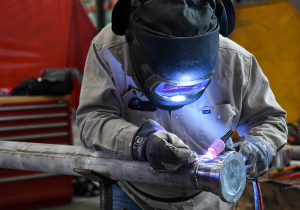
What Is Presswork?
Presswork, also known as metal stamping or pressing, is a manufacturing process that uses mechanical or hydraulic presses to shape or cut metal sheets using dies. This process is often automated, allowing for fast and repeatable production of components with consistent quality.
In presswork, a flat metal sheet is inserted into a die set, and a punch presses the material into a specific shape. Depending on the die design, this can involve cutting, forming, or shaping operations.
Common Presswork Operations
- Blanking: Cutting a flat piece from a sheet, which becomes the base for further processing.
- Bending: Forming angles, flanges, or curves in the sheet, commonly used for making boxes, enclosures, and brackets.
- Punching: Creating holes, slots, or cutouts with precision.
- Drawing: Stretching metal into three-dimensional shapes, often used in making cans, sinks, or automotive panels.
When to Use Presswork
Presswork is the preferred method for mass production of components that need high speed and consistency. It is ideal for:
- Automotive components like fenders, brackets, and panels.
- Appliance bodies, such as washing machines or oven frames.
- Electrical housings and metal casings.
- Thin metal parts where high volume and precision are required.
Pros of Presswork
- Extremely efficient for large batches, reducing per-unit costs significantly.
- Highly repeatable, with minimal variation between parts.
- Produces minimal material waste due to optimized cutting patterns.
- Excellent speed, with thousands of parts producible per day once tooling is ready.
Cons of Presswork
- High initial tooling cost, including die design and manufacture, makes it less economical for low-volume runs.
- Limited design flexibility, since any changes to the part design require a new die.
- Not ideal for thick or very hard materials, which may need alternative fabrication methods.
- Setup time can be long, requiring careful alignment and calibration of machines and tools.
If you need large-volume metal components shaped with speed and precision, Kirmell offers advanced presswork solutions using high-quality tooling and experienced operators.
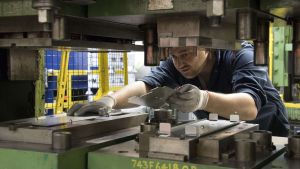
What Is Machining?
Machining is a subtractive manufacturing process where material is removed from a solid block (workpiece) to achieve the desired shape. It involves a range of techniques, including:
- Turning: Rotating the workpiece against a cutting tool (done on a lathe) to create cylindrical parts.
- Milling: Using rotating cutters to remove material in different directions for complex geometries.
- Drilling: Creating precise holes.
- Grinding: Smoothing and finishing surfaces with abrasive wheels.
Modern machining often uses CNC (Computer Numerical Control) systems, which allow for automated and highly precise operations. The operator programs the CNC machine, which follows exact paths to create complex parts with fine tolerances. Read more about the CNC machinery in our guide.
When to Use Machining
Machining is ideal when you need precise, complex parts, especially in lower volumes. Use machining for:
- Prototypes or custom components.
- Aerospace, medical, and precision engineering parts where tolerances are critical.
- High-performance tools and molds are used in other manufacturing processes.
- Parts with internal threading, intricate cutouts, or detailed engravings.
Pros of Machining
- Extremely high accuracy and repeatability, often within microns.
- Excellent surface finish, especially after grinding or polishing operations.
- No expensive dies or moulds required, which reduces setup cost for small batches.
- Supports a wide range of materials, including metals, plastics, and composites.
Cons of Machining
- Slower production speed, especially for high-volume manufacturing.
- More material waste, since excess is removed during cutting.
- Higher cost per unit, particularly when compared to processes like presswork for large runs.
- More complex setups and programming are required in the case of CNC machining.
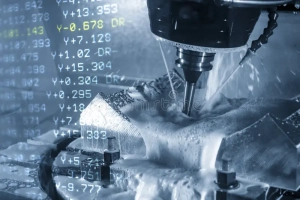
Key Factors to Help You Decide
Now that you know what welding, presswork, and machining are, the next step is figuring out which process is best for your specific metal project. Each method has its strengths, and choosing the right one depends on your needs for volume, accuracy, complexity, and budget.
Let’s break it down in simple terms:
Volume of Production
Think about how many parts you need to make. The number of parts can help you choose the right process:
- Low Volume or Prototypes:
If you’re making just a few items or testing a new design, machining is your best option. You won’t need to spend money on expensive tools like dies or molds. It’s flexible, and changes can be made quickly without extra cost. - High Volume with Repetitive Parts:
For large quantities of the same part, like thousands of identical brackets or panels, presswork is the winner. Once the die is made, you can stamp out parts quickly and cheaply. - Small to Medium Volumes with Assembly Needs:
If your project involves making a few hundred parts that need to be connected or joined together, welding is a great choice. It gives strong, lasting joints and allows for flexible designs.
Design Complexity
How detailed or complex your part is also matters:
- Simple Shapes (Flat or Bent):
If your parts are straightforward, like a flat plate with a few bends, presswork or welding is usually enough - Complex Shapes or Fine Details:
If your part has curves, holes, slots, or specific angles that need to be just right, machining is better. CNC machines can handle tight corners and unique shapes that pressing or welding can’t achieve easily. - Parts Requiring Bending and Joining:
Some parts need to be bent first and then welded. In this case, you can combine presswork for shaping and welding for joining. This method is common in custom furniture frames, metal enclosures, or vehicle parts.
Tolerances and Accuracy
How precise does your part need to be? This is where tolerances come in. Tolerance means how much variation is allowed from the exact dimensions.
- Loose Tolerances:
If a few millimetres here and there won’t hurt the function of your part, then welding or presswork will do the job just fine. - Tight Tolerances (High Precision):
If your part must fit perfectly with another part, such as gears or tools, machining is the way to go. CNC machines can cut down to fractions of a millimetre with extreme accuracy.
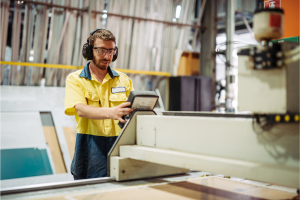
Material Type and Thickness
Not all metal is the same. The kind and thickness of your metal affect which method to choose.
- Thin Sheets: For metals like aluminium or stainless steel sheets, presswork is great for shaping, and spot welding works well to join pieces together without too much heat damage.
- Thick or Solid Materials:
When working with thick bars or plates, machining helps shape them accurately. Welding (especially arc welding) is also good for joining thick materials. - Hard-to-Machine Metals:
Some metals are tough to cut with machines (like titanium or high-carbon steels). These can sometimes be easier to weld than to machine, especially if you just need to connect pieces rather than shape them.
Time and Budget
Your timeline and money can strongly influence your decision.
- Tight Budget, Long-Term Production:
If you’re willing to invest at the start and plan to produce the same part for a long time, go with presswork. Once the tools are made, each piece costs very little. - Quick Turnaround or Prototyping:
For projects that need to be finished fast, or when testing new designs, machining is better. No need for tooling, and changes can be made quickly on the computer. - Custom Assembly or One-Off Projects:
If you’re making one-of-a-kind pieces, welding is flexible and cost-effective. It allows you to assemble complex items without the need for expensive tools or machinery.
Combining Methods for Better Results
In real-life manufacturing, many companies don’t rely on just one method—they combine them to get the best results. This is often called a hybrid approach.
Here’s an example of how it works:
- Use presswork to create flat parts with holes or bends.
- Use welding to join those parts into a complete assembly or frame.
- Use machining to fine-tune holes, slots, or edges for perfect fitting or to meet tight tolerances.
This combination gives you:
- Fast production from presswork
- Strong and flexible assembly from welding
- High accuracy and finishing from machining
Industries like automotive, aerospace, agriculture, and heavy machinery use this blended approach all the time. It offers the best of all worlds: speed, strength, and precision.
Case Study: Choosing the Right Method for Metal Project
Let’s say you need to manufacture a metal enclosure for an electronic device.
- Material: Mild steel, 1.2 mm thick
Requirements: Mass production (10,000 units), cutouts for ports, bend angles, consistent quality
Best Choice: Presswork
- Use blanking to cut the flat shape
- Apply bending dies to form sidewalls
- Add piercing dies for holes and cutouts
However, if the enclosure design needs revisions or the volume is only 200 pieces, then machining or laser cutting + bending might be more cost-effective.
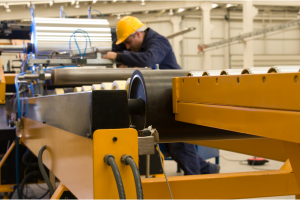
How Kirmell Can Help?
At Kirmell, we understand the importance of choosing the right manufacturing process for your unique needs. Our team offers in-house welding, CNC machining, and presswork services, helping you select the best route based on design, volume, and material requirements.
Whether you need a few precise prototypes or thousands of consistent parts, Kirmell’s experienced engineers and technicians will guide you every step of the way. With a commitment to quality, speed, and cost-efficiency, we turn your metal projects into reality. Contact us today to get started on your project.
Conclusion
There’s no one-size-fits-all answer when it comes to metal fabrication. Welding, presswork, and machining each play unique and important roles in manufacturing. Choosing the right method depends entirely on your specific project goals.
You need to consider whether strength or precision is more important, how many parts you need, whether it’s just one or ten thousand, and what materials and tolerances are involved. These questions help guide you toward the most effective and cost-efficient approach.
And if you’re still unsure about which method suits your project best, a consultation with an experienced fabrication provider, like Kirmell, can save you valuable time, money, and unnecessary stress in the long run.
FAQs
What is the most cost-effective metalworking method for high-volume production?
Can I use CNC machining for large-scale production?
Is welding strong enough for load-bearing applications?
Which metal fabrication method offers the best precision?
Can I combine machining and welding in one project?

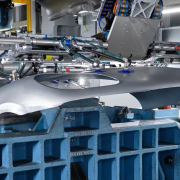
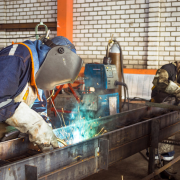
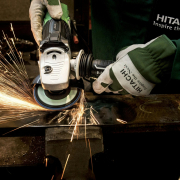
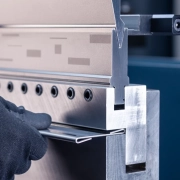
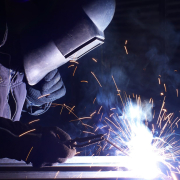
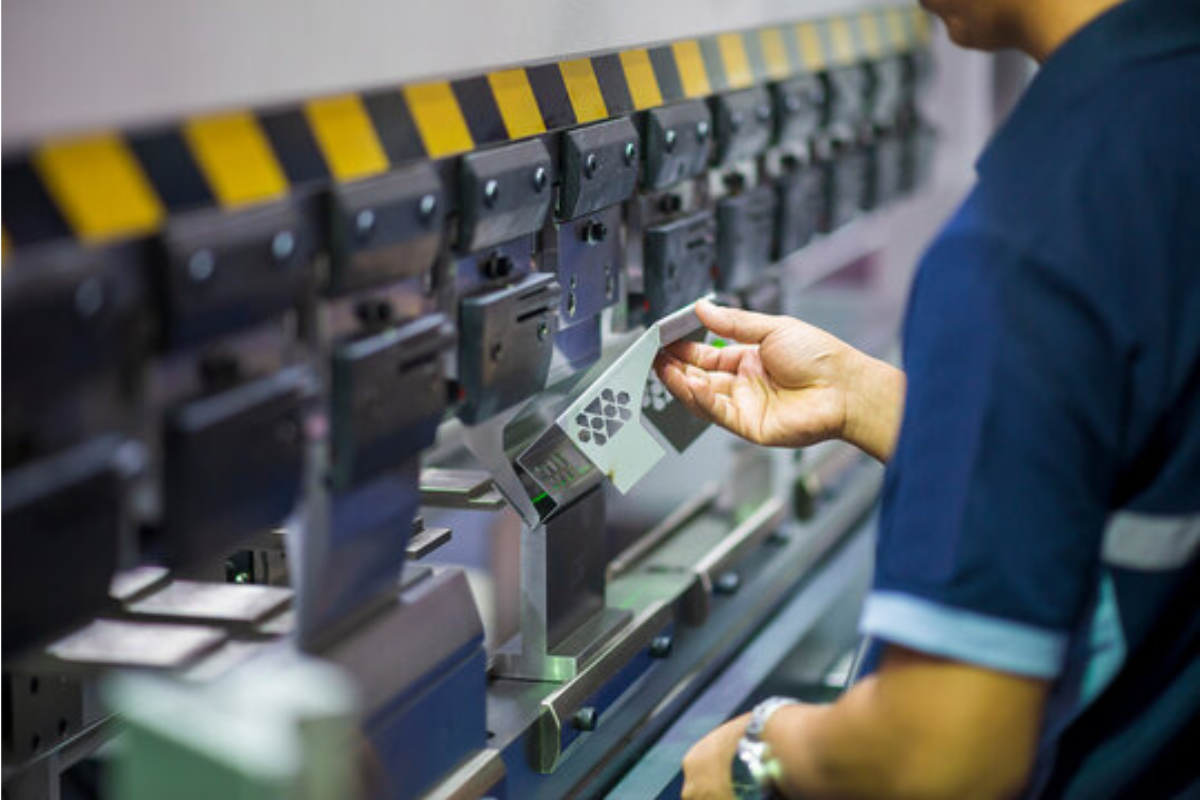
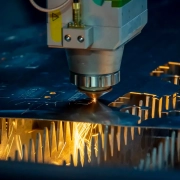
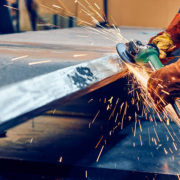



Leave a Reply
Want to join the discussion?Feel free to contribute!